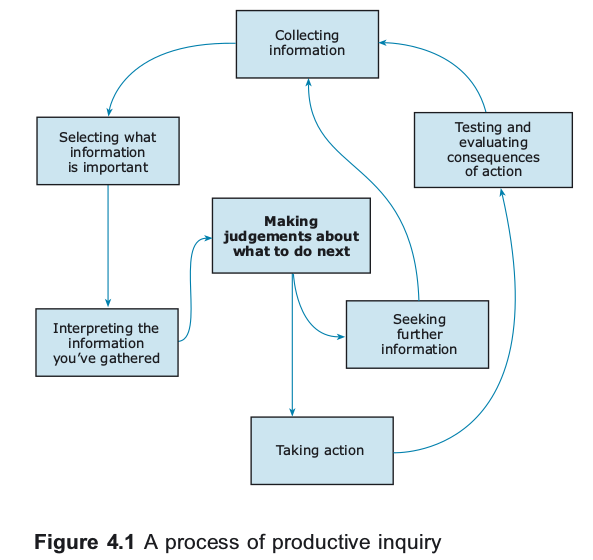Inquiry should form the basis for leadership decision-making and action, because without productive inquiry you cannot be certain what needs to be done. Here’s a bit I wrote for an assignment while studying Leadership, Influencing and Change with the Open University.
What is Inquiry?
Dewey defines it as “determination of an indeterminate situation” in his book Logic: the Theory of Inquiry (1938). He sees patterns of inquiry as a sequential process which iterates following experimentation. Dewey links this to the scientific method, there is a need to gather information, and to make conscious practical tests of theory developed through reflection.
Cook & Seely Brown (1999) expanded on Dewey’s theory by bringing in organisational theory, distinguishing between knowledge and knowing, and interaction with the real world. In blending these ideas Cook & Seely Brown show that there is more to learning than simply gathering knowledge. They distinguish between different sorts of knowledge and how you acquire them.
Productive Inquiry

Ramsey (2013) synthesises this to define Productive Inquiry as the process by which you set out to answer a question. Productive Inquiry has three key features, it:
- always involves other people;
- is ephemeral – it looks for the next action;
- involves iterative sense making.
In summary productive inquiry needs to have a focus. A question to answer or a problem to solve. It gathers information from multiple sources, involving other people. The inquirer makes judgements about the information that they receive and formulates theories which are then tested. The process is active and iterative.
What methods are there?
Ramsay identifies productive inquiry as most likely being ethnographic research, which is where the researcher is part of the group being researched, an insider. Further, Ramsey identifies the following methods of inquiry:
-
Conversations and interviews
-
Observation
Conversations and Interviews
These involve speaking to people and are typically qualitative research. The differences are the level of structure, and the formality of the meeting. Typically interviews are advertised in advance and tend to be more structured. Conversations can be more fluid.
Documentary Research
This involves reading relevant material. This could be management information reports, working with questionnaire responses, procedures or policies, or any other form of documentary material.
Observation
This covers watching people do things, running physical experiments, looking for environmental clues and interpreting what is happening rather than what people say. Often observation happens alongside other forms of inquiry.
Forming Questions
Framing Questions
In pursuing a productive inquiry Ramsey cautions the researcher to be careful, because answers depend on the context. Tversky & Kahneman (1981) showed that people could be induced to make different decisions when questions were framed differently. This is equally true for productive inquiry, which Ramsey demonstrates with an excerpt from Yes, Prime Minister (BBC, 1986).
Open or Closed
Closed questions can typically be answered yes or no, or with a predictable answer. Open questions lead to discursive answers. When conducting quantitative research closed questions are easier to analyse. However their primary shortcoming is that the answers are all guided. You can ask whether people want to stay with your organisation and get a yes/no, but not why.
Choosing a method of nquiry
Given the number of methods of inquiry, and that you can change method between each cycle of inquiry, it might be best to start with a relatively informal and unstructured method. This could help to define the problem without risk of guiding answers or following the researchers pre-conceived ideas. It would also help to show what interviewees saw as important.
However before progressing to unstructured conversations using open questions it would be useful to undertake some documentary research to enable the identification of lines of inquiry. These would assist in the preparation of suitable open questions that could get the conversation subjects talking about their perspective.
References
Cook S.D.N, Brown J.S., (1999) Bridging Epistemologies: The Generative Dance Between Organizational Knowledge and Organizational Knowing. Organization Science 10(4):381-400. http://dx.doi.org/10.1287/orsc.10.4.381 [accessed 22 October 2016]
Dewey, 1938, Logic: The Theory of Inquiry, Henry Holt and Company, New York.
Ramsey, C. 2013, Management, Inquiry and Action, The Open University, Milton Keynes.
Tversky, A. & Kahneman, D. 1981, ‘The Framing of Decisions and the Psychology of Choice’ Science, New Series, Vol. 211, No. 4481 (Jan. 30, 1981), pp. 453-458, American Association for the Advancement of Science [online] http://www.jstor.org/stable/1685855 (accessed 23rd October 2016)




